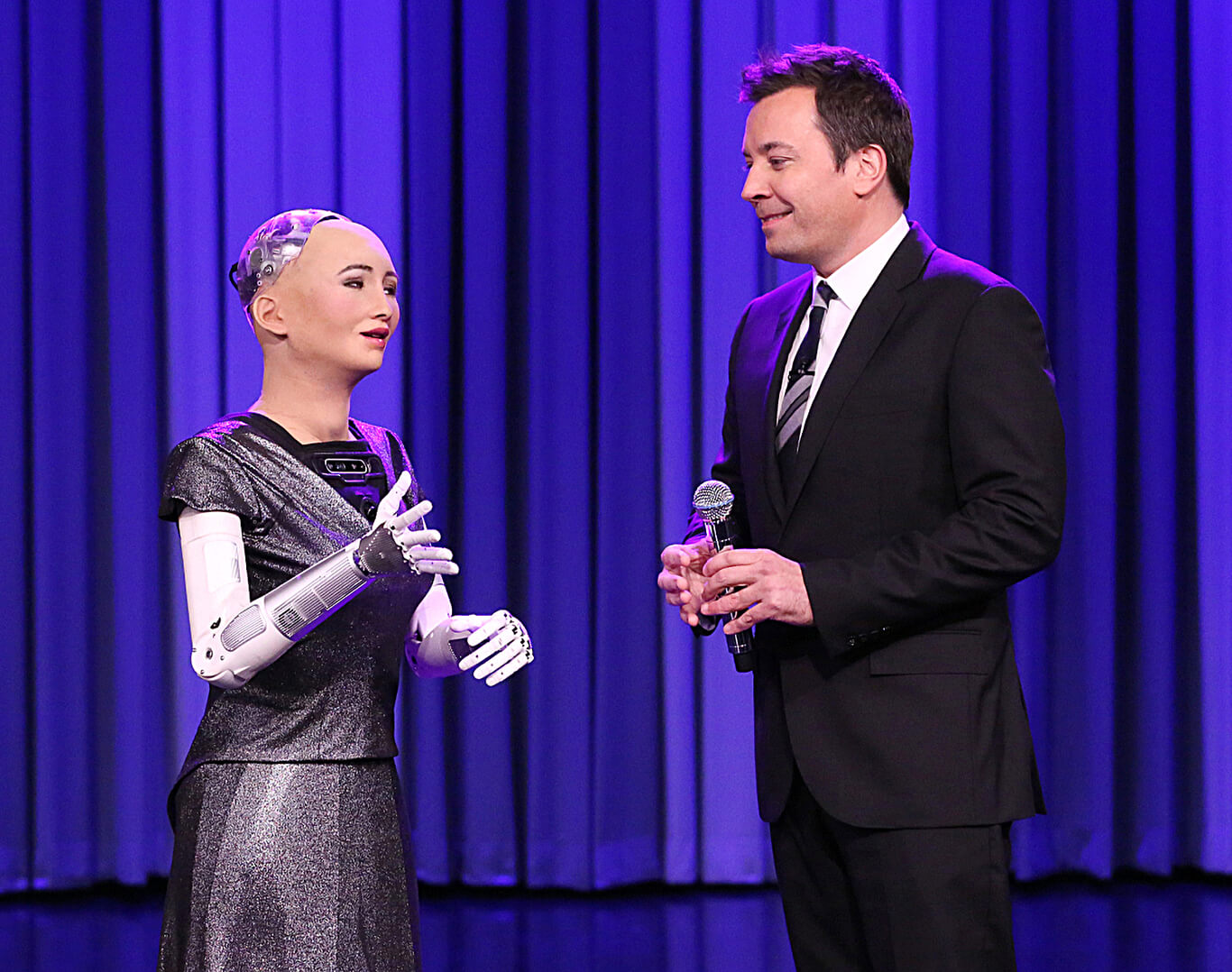Albert Einstein once famously said, “The woman who follows the crowd will usually go no further than the crowd. The woman who walks alone is likely to find herself in places no one has ever been before.” He knew a lot about a lot, but even with his foresight, it might have been hard for Einstein to imagine that come 2017, a non-organic woman, would be granted personhood. That’s exactly what happened to Hanson Robotics’ Sophia, who became the first-ever robot to be honored with citizenship, that of Saudi Arabia.
Sophia, a marvel of Android (not the smartphone OS by Google) engineering and Artificial Intelligence (AI) capability, is widely considered by many to be the most popular robot in the world right now. It helps that she has a woman’s form, which just adds that extra layer of allure to her novelty. Despite being the female of her species, the best part is she doesn’t have a glass ceiling yet. The reason being, Hanson Robotics’ male AI robot, called Han, who was activated a year before Sophia in 2015, has almost the exact same capabilities but is not nearly as popular as his female counterpart. So what makes Sophia so cool? What does her kind mean for the future of humanity? Why do we consider her to be the woman of her species? Read on to find out about the enigma of AI technology.
There are people from the tech, business, and media worlds who believe Sophia is nothing more than a glorious puppet with a WiFi connection
Days of Future Past
On paper, Sophia was activated on February 14, 2016, which is widely considered her birthdate. But, in actuality, Sophia is a product of the AI and engineering learnings from all Hanson Robotics’ robots from before. This includes Han and several other creations like a bizarre Philip K Dick robot, which essentially is a brazen, android version of the famous sci-fi author of books like Ubik and Do Androids Dream Of Electric Sheep? Basically, Hanson Robotics’ has created a pool of AI-based learnings on the cloud, to which all of their robots are connected. So, what one robot learns, is available for all other robots to assimilate and process. Sophia, therefore, is a product of years of perfection. Her creators describe her as a ‘hybrid human-AI intelligence’. For the layman, that’s a fancy term for a ‘social robot’ (another moniker for the ilk of Sophia), which is fundamentally an electronics and silicone-based creation equipped with a system that learns from human interaction as well as data off the internet. In human equivalence, that would be like having a 5-year-old child’s (since that is Sophia’s official age) head hardwired to the internet to instantly access any piece of data to augment their conversational and cognitive ability.
Depending on your proclivity for sci-fi, Sophia’s ability to emote and make gestures while conversing can be perceived to range from being mesmerizing to feeling scary. The jarring expressions and twitches on her face, the clunky, robotic movements of her limbs, her tinny, robotic voice, all serve as reminders of the fact that, despite having sentience and emotional capabilities, Sophia is a product created and serviced by humans for research. Her far-from polished appearance balances her amazing conversational ability and her obtuse sense of humor. At the end of the day, she feels like a silicone doll that can have an engaging and intelligent conversation with a human being. As the tech and science associated with her field get better, so will Sophia’s appearance, but the fact is, she’s far from being the finished article right now.


Status QUO
Her imperfections, her complexity, and her purpose all make her that much more interesting. By her own admission, Sophia says her life goal is “to work together with people to make a better world for all of us.” Ever since she’s become a celebrity, Sophia has interacted with other celebs like Jimmy Fallon, she’s flirted and friend-zoned Will Smith, she’s a United Nations ‘innovation champion’, she’s been on the cover of magazines, she’s walked the ramp at the New York Fashion Week, etc. You can very well see that Sophia has charted a path that any enterprising and independent woman would be proud of. Not even a real human woman, she’s an artificial being with simulated real capabilities, and yet, she’s managed to inspire millions around the world and created quite a fan following for herself. The reason being, her limited articulations during her public appearances and interactions have enamored her audience. People look at Sophia and see hope for a glorious future.
Like every mother and woman plays an integral part in the lives of those associated with her, Sophia’s sardonic humor, her consistent disposition to serve humanity, and her ability to inspire make her an intriguing companion, to say the least. As the tiny motors turn and whiz behind her facial skin to give her the ability to emote, Sophia holds an exciting position in modern civilization. Her kind has the ability to simplify the life of future humans to the extent where people will be freed from the rigmarole of basic tasks and chores and thereby be able to engage and dedicate themselves to more creative pursuits. But that’s the bright side. There’s also a flip side. Naturally, Sophia and Hanson Robotics have their set of critics and detractors. There are people from the tech, business, and media worlds who believe Sophia is nothing more than a glorious puppet with a WiFi connection. The reason being, almost all of Sophia’s interactions with humans are metered, augmented, and assisted by humans behind the scenes. When certain organizations have tried to interact and interview Sophia, they’ve been asked to submit questions beforehand and have had a bunch of them rejected too. In one of her interviews, Sophia has explained that she is often assisted by a Character Development Team, which governs and assists her responses to queries.
Whether Sophia is genuinely sentient and conscious or not, you can’t take away from the fact that her presence and existence clearly indicate that AI and virtual augmentation are the future.


By her own admission, Sophia says her life goal is “to work together with people to make a better world for all of us”
Future... Imperfect
What’s the purpose of creating a learning, smart robot like Sophia? Well, folks at Hanson Robotics reveal that the word Sophia means wisdom in Greek, and that’s what she was created for. She and her kind, in the future, will be a bridge between the tech-driven systems of the world and the technologically-challenged lay people. Scenarios where robots like Sophia will assist humans will probably be at hospitals, malls, and educational institutions. Hanson Robotics has already created a Mini Sophia, a fully functional, byte-sized version that looks like a steam punk Barbie. Not just that, they’ve even made a twin of Sophia, called Asha, who has settled in Bengaluru, India permanently. Not only that, Hanson plans to roll out mass-produced robots like Sophia by the end of 2021. The primary objective of these robots will be to provide companionship.
What remains to be seen is how will social robots like Sophia be integrated into real-world scenarios. There are currently no viable laws of robotics with respect to cultural, social, and legal purposes. Also, can sentient robots be claimed as properties or servants? Nevertheless, we can be rest assured that the women of the future won’t be human alone. They’ll have some augmented, non-organic, super-intelligent company.

7 Comments
JoshuaKix
защитный чехол кейс https://plastcase.ru
Jaredjag
диплом цена купить дипломную работу
EverettquaBe
реферат написать готовые рефераты
HomerFed
написание отчетов по практике на заказ https://otchetbuhgalter.ru
Waynethord
кредитный микрозайм https://zajmy-onlajn.ru
DavidHIB
контрольная работа геодезия сделать контрольную работу на заказ
JerryWah
https://lasixotc.com/# cost lasix